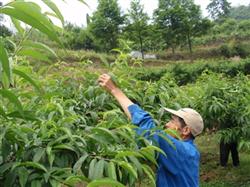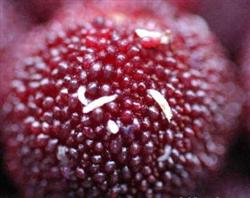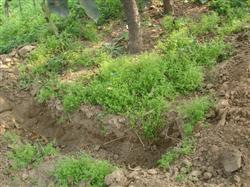How to manage honey peach trees in autumn?

How to manage honey peach trees in autumn? Please introduce the management methods of honey peach trees in autumn, which mainly include pruning, pest control and water and fertilizer management in autumn. The following operation methods are introduced in detail for reference: first, timely pruning of honey peach origin is high above sea level and strong light, forming the special light-loving characteristics of peach. in addition, honey peach branches have many lengthening growth peaks and many secondary shoots occur, so timely pruning in autumn Creating good ventilation and light transmission conditions is more important than other tree species. (1) thinning branches. Timely remove too dense, thin and weak, diseases and insects, upright useless branches and long leafless branches, etc. (2) pull branches. For the growing upright peach trees, the methods of pulling branches, hanging branches and supporting branches are adopted to increase the angle of the main branches and ease the tree potential. (3) twisting. The competitive branches and the upright branches with space reservation can be twisted and pressed, and the strong branches in the upper part of the crown can be sprained or pressed from the base to control their growth, promote the further differentiation of flower buds and make use of their results. Should be careful when twisting, can twist 180 degrees, but can not break. (4) retraction. The overlapping branches, cross branches and old and weak branches in the crown can be retracted, and the middle and long branches which have been fruited at the end can be retracted in time, leaving 3 prepared branches at the base to promote their growth. Pick the heart. Pick the hearts of some greedy young shoots in late autumn or take other length control measures to promote the maturity of branches. Second, although drought-resistant and waterlogging peach is a drought-tolerant tree species, in order to obtain high yield, high quality and stable yield, water supply must be ensured in time in each growth period. Especially in the north where there is little rain, if the drought persists in autumn, we should try to replenish water, which is especially important for late-maturing varieties. Peach trees are resistant to drought and avoid waterlogging, and special attention should be paid to waterlogging in rainy autumn. In the rainy season, the tree plate is arranged into high inside and low outside combined with weeding in the rainy season, so as to prevent the accumulation of water at the neck and cause the root of the neck to rot. The shallow harvest after light rain and deep hoe after heavy rain summed up by fruit growers in northern fruit areas should be popularized for drought prevention and drainage. Third, pest control can protect the leaves and branches of peach trees from diseases and insect pests in autumn, which can improve the photosynthetic efficiency of the trees, increase the reserve nutrition, and have a great impact on the yield and quality of late-maturing fruit in the same year and the fruit in the coming year. Peach trees can be used in autumn, such as imidacloprid, thiazuron 3, etc., and fungicides can be selected, such as polyantimycin, Dasheng and so on. For trees with glue flow, first scrape off glue spots and warped skin, and then smear the glue with quicklime. 4. The practice of applying base fertilizer in autumn shows that the application of base fertilizer in autumn blossoms earlier and the fruit setting rate is higher than that in spring. The application of base fertilizer in autumn should be based on organic fertilizer and adding appropriate amount of chemical fertilizer, mainly nitrogen, phosphorus and potassium, with appropriate amount of medium and trace elements. The amount of fertilizer applied should account for 60% of the annual amount of fertilizer applied. Based on the yield and growth potential of adult trees, 200 kg of organic fertilizer, 0.7 kg of available nitrogen, 0.5 kg of available phosphorus and 1.0 kg of available potassium were needed for every 100 kg of peach fruit. The newly planted young trees are mainly organic fertilizer, with no or less nitrogen fertilizer. For varieties, early-maturing varieties and varieties with strong upright can apply less nitrogen, while old trees and weak trees should increase the amount of nitrogen fertilizer. The best time to apply base fertilizer in autumn is around September, and it can also be combined with autumn ploughing before and after defoliation, and the fertilization method is the same as that of other fruit trees. In recent years, for trees with large fruit, some fruit growers have a good effect of spraying 2 Mel 3 times 0.3 Mel 0.5% potassium dihydrogen phosphate on leaves after fruit harvest, with an interval of about 15 days. In order to ensure the water supply of honey peach trees during the overwintering period, it is necessary to irrigate frozen water once from late October to mid-late November after applying base fertilizer in autumn, and make the water wet through the dry soil layer. If there is more autumn rain, the soil moisture is good, and the stickier soil can be irrigated lightly or without irrigation. Click to get more peach tree planting techniques click to get more fruit planting techniques
- Prev

What are the bugs in bayberry?
What are the bugs in bayberry? Is it harmful to human body? How can you get rid of bugs in bayberry? Please introduce that the white bug in bayberry is actually the larva of fruit fly, because red bayberry is not protected by pericarp and will naturally attract fruit flies to lay eggs on the fruit. When the fruit fly is not yet mature, the mother worm will.
- Next

How is the effect of peach base fertilizer applied in autumn?
How is the effect of peach base fertilizer applied in autumn? Why should peach tree base fertilizer be released in autumn? Please introduce the reasons why peach tree base fertilizer is applied in autumn: high temperature in autumn, more Rain Water, high soil moisture and high soil temperature. Fertilizer is applied to fruit trees in time. Fertilizer decomposes quickly in the soil, fertilizer effect time is long, peach trees are easy to absorb.
Related
- Moge, come on! The staff of the peasant association in the producing area of cantaloupe were frightened when the crowd gathered.
- Causes and Solutions of low Fruit setting rate of Apple
- Symptoms and control measures of passion fruit virus disease
- Fruit growing lesson: how do apple orchards keep high yields?
- Can you build orchards in the mountains? What are the pros and cons?
- How to manage the coloring period of Crisson grape?
- This paper introduces the processing technology of two kinds of fig products.
- How much is a month for retired teachers in rural areas by 2020?
- How can strawberry planting increase sugar content? We should pay attention to management in many aspects.
- What are the cultivation techniques on how to improve the yield of golden fruit?

